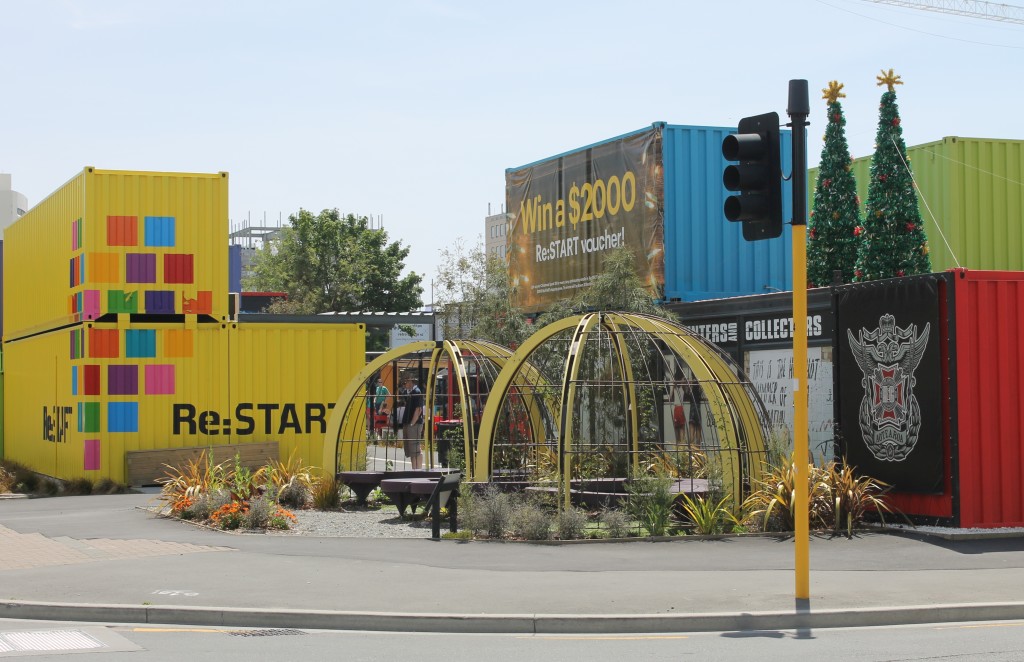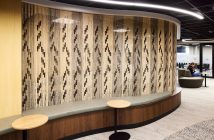The pop-up revolution offers commercial landlords a life-line as online shopping lays waste to high-street retailers.

The Re:START mall helped revive Christchurch’s CBD after the 2011 earthquake
Disruptors. It sounds like a name Hollywood would dream up for giant, all-killing robots that flatten cities and threaten the Earth. For established industries the world over, the word is just as terrifying. Disruptors have laid waste to previously successful business models, and left many a company on the slag heap. The High Street has felt its effect more than most. The once-reliable anchors of retail – older retail chains that used to be teaming with eager shoppers and mouth-watering transactions – have been vanquished by an army of smarter and more nimble online retailers, which have responded to consumers looking for new brands, new ways to shop and better prices.
Legacy stores, crippled by higher costs and longer production schedules, can’t compete. Stores lie vacant, a sad reminder of the past. The renaissance in malls has provided protection for many but the problems are still there.
Commercial landlords who have long relied on the attractiveness of their conveniently placed retail spaces face diminishing returns. Who can afford to take a bet on a long-term lease when shoppers can’t be bothered to leave their couches? Empty spaces are a financial strain. But not all disruptors are threats. In the Darwinian sales environment, there is one that’s proving to be a winner for both retailers and landlords … the pop-up store.
Pop-ups – the temporary conversion of an empty space into anything from a commercial outlet to an art gallery – have been around for years but the format has only recently made a move into the mainstream. In the past, they were seen merely as vehicles for hip “indie” retailers or marketing events or as cheap discount stores.
Retailers and landlords who previously ignored or dismissed pop-ups, perhaps because they lacked the courage or know-how to try them, now see them as an opportunity to reach out to new customers. Pop-ups are, well, popping up in malls, high streets, warehouses, garages and even around pools.
In the US one artist even opened a pop-up gallery in a giant Christmas tree. Even Kanye West has gotten in on the act. When he brought his Yeezus tour to New York, he sold his merchandise not from a booth at the concert venue but at a pop-up shop in one of the city’s hip shopping areas. The store was quickly emptied by hordes of West fans, generating lots of coverage.
Dare to be creative
The rise of pop-ups is partly due to the fact they provide a neat solution to a persistent problem: empty shops. The temporary nature of pop-ups means the risk is low for all parties involved.
Retailers can take a gamble on a new location or new product, while landlords can fill their spaces more quickly, and expand their client base.
Through the power of the popup, previously forlorn sites can be transformed into vibrant commercial hubs. For experienced practitioners, pop-ups fuel sales, with many in the US noting their e-commerce customers are among their biggest spenders in their pop-up stores.
Using pop-ups can help entrepreneurs stay nimble and lean. They do not need to sign long leases, stash away much cash or carry big credit lines. Consumers can meet the designers and touch and feel their works, which cannot be done online. In the process, brands can be built more quickly, sales can be increased and new products can be tested.
Greg Harford, of Retail NZ, says pop-ups are a permanent part of New Zealand’s retail landscape, and that they will become an increasing phenomenon “because not only are they popular with consumers out looking for a deal, they present an opportunity for retailers”.
“Retail is constantly reinventing itself – new stores are coming in and old businesses are closing down. Pop-ups are part of the mix”, even though they represent a “relatively small slice of the retail pie”, he says.
Pop-ups, he says, can be broadly split into two categories: those set up by established retailers, who are looking to clear reasonably quickly certain lines of product, and those set up by less permanent retailers, who are looking to take advantage of a particular event or location.
“Nowadays we operate in 24-7, global shopping environment. Customers are becoming increasingly used to looking for a great deal, and pop-up stores dealing in particular lines of product are an opportunity for retailers to tap into that.”
There is no one pop-up demographic. “Customers who use pop-ups are probably from all walks of life. Kiwis love to shop, whether that’s in pop-ups or established retail environments,” Harford says. “The key to a successful pop-up store is location. If you are in a high traffic area, then you are more likely to clear your product.”
Harford believes pop-ups compliment rather than compete with established stores. “Change is continuous in the retail market. It’s constantly evolving, which you can see on an individual store level but also globally. Pop-ups offer a different experience to the more permanent retail stores. From a customer point of view, you probably have different expectations going into a pop-up.” For many pop-ups, the customer experience is targeted and instantaneous. “It’s not like going into a high-end shop for a lengthy shopping experience. For retailers, pop-ups offer a chance to test a product without all the expense of fit-outs,” Harford says.
He adds: “Commercial landlords are always going to prefer a high-end retailer on a lengthy lease but pop-ups are an opportunity for them to fill the gap between permanent tenants.”
Beacon of hope
Pop-ups can revitalise down-at heel suburbs or zombified high streets. Aspiring retailers are turning empty stores, warehouses and other commercial spaces into laboratories for temporary businesses. In Christchurch, a pop-up mall was a colourful beacon of hope for a city trying to find a way through the pain of the devastating earthquake of February 22nd, 2011. The Re:START mall brought life back to Christchurch’s abandoned CBD. It grew from 27 businesses to well over 50 and has been instrumental in helping Christchurch not only recover financially and psychologically but also become a desirable tourist location. The mall is frequently cited by reviewers who place the city in top 10 lists of “must visit” places.
Harford says: “When you look at some of the smaller towns that have turned themselves into retail destinations – places like Shannon and Manawatu, which several years ago were down-at-heel in terms of the retail experience – then you can see how the arrival of pop-ups there helped other retailers feel more confident about the environment.”
Lizzi Hines is the founder of Pop UP Now, an Auckland-based design company that is the Airbnb of retail, connecting brands in need of temporary quarters with landlords who have retail spaces for short-term lease. The retail designer saw a gap in the New Zealand market after noticing how popular pop-ups had become in Europe and the US.
“I always thought New Zealand was really quick on the uptake but it has been quite slow in regards to pop-ups. I had been watching a TV programme in the UK about pop-ups and I became very intrigued. I could see that New Zealand hadn’t quite cottoned on to the pop-up concept, but I was really excited about how it worked in terms of brand activation and space activation. Popups created a bit of spunk – they are not all the same,” she says.
“To create a pop-up you’ve got to have a lean business model. So we decided to create a business that could meet the market. Start-ups are very reluctant to sign long-term deals, especially if it is their first retail store and they haven’t had an opportunity to test the market or choose a location. We looked at it from the perspective of ‘how do we help give retailers a leg-up to give the market a try?’”
Changing attitudes
To many people not in the real estate business, the notion that landlords can leave empty spaces for years can be daunting. Hines says landlords and leasing agents in New Zealand have yet to fully realise the benefits pop-ups. For a leasing agent, there’s little incentive to get a pop-up into an empty space, she says. “The rental and commission to be gained on a three-month pop-up are not particularly significant. We’re definitely trying to educate landlords and agents on how important it is to activate a space. Our approach to agents is: If you’ve got a space that’s a bit stagnant, give it to us, and if it turns into a long-term deal, we’ll pass the clients back to you.”
A good pop-up can be an effective way of advertising the space it fills. Hines says: “A lot of retailers, particularly if they are first time-retailers, don’t know what a space is going to look like unless they see someone in there first. Seeing an active space can be an incentive to signing a long-term lease. For landlords, it makes them a bit of coin in the meantime.”
Pop-ups, she says, are an ideal way to test new products or revitalise a brand. “We did a pop-up for a large juice manufacturer that wanted to test a new product but didn’t want anybody to know the brand behind it. And then we did a pop-up for Molenberg, which wanted to get people excited about bread.”
She says there is clear difference between these pop-ups and the ones used by big retailers to clear stock.
“I hate calling the clear-out ones a pop-up because they are just a dumping ground. True pop-ups provide something of value to the market, such as brand activation or location testing, whereas clearance stores are a tool retailers use to get rid of stuff,” she says.
“I think pop-ups are far more sensory than traditional retail. People that are going into traditional retail are there for the longterm. Whereas people coming in for popups are more interested in what people are actually looking for. The experience we’ve had is that owners of pop-ups are more interested in what their customers want rather than trying to sell product. So they really start from the customer end rather than ‘what are we going to sell?’”
She says pop-ups offer huge opportunities for the hospitality industry. “A lot of bars don’t really hang around longer than a couple of years, so if you can treat them like a pop-up, you can be constantly earning money because it’s that new and exciting place.”
Boredom v excitement
In the UK and the US, where up to 20 percent of shops can lie vacant, big brands are developing pop-up strategies and service companies such as those run by Hines are attracting big backers. Some critics argue that the involvement of big corporations in pop-ups is a sign of desperation. However, Hines believes pop-ups can complement and boost established retailers. “Most malls have pretty much the same retailers and offer the same, stagnant shopping experiences, and it’s just boring. By embracing the pop-up concept, and treating them as an activation zone where there are new and different things going on, malls can excite shoppers and bring them back. “Big retailers who tend to have a uniform look for their stores can use pop-ups to try something entirely different. They can revitalise a particular brand and give their existing customers a different experience, rather than just throwing the exactly the same store into every location. Wouldn’t it be great to have half the retailers on long-term leases and have the other half as pop-ups? It would just start to change the market.”
Credit: Total Property



